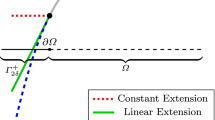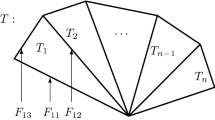Abstract
Getting a pair of compatible and equilibrated solutions is a prerequisite for dual analysis. Generally, compatible solution is obtained by the conventional displacement-based finite element method (FEM), while equilibrated solution can be achieved via the equilibrium finite element method (EFEM). However, the existing EFEM involves more complex construction of the equilibrated field or more degrees of freedom (DOFs), which to a great extent hinders the widespread popularity of the EFEM. Aiming to overcome this limitation, a simplest node-based equilibrium element for general 2D Poisson equation with simply- or multiply-connected domain is proposed in this paper. This element is directly derived from simple nodal interpolation of Prandtl stress function for a simply-connected domain, while specialized hole-dependent discontinuous stress functions are additionally introduced to enable representation of non-zero resultant hole fluxes in a multiply-connected domain. As a result, the proposed equilibrium formulation has almost the same amount of DOFs and the same exponential ratio of the condition number (of system matrix) to the mesh size when compared to the conventional FEM. Further analysis shows that hybrid, flux-based and stress-function-based (or the proposed node-based) equilibrium elements are equivalent to each other, but the node-based element is the most efficient. Numerical examples are studied, and the results indeed verify the accuracy, the convergence and the ability to strictly bounding the error of the proposed node-based EFEM.

















Similar content being viewed by others
Data availability statement
All data, models, and code generated or used during the study appear in the article.
References
Ladevèze P, Pelle JP (2004) Mastering Calculations in Linear and Nonlinear Mechanics. Springer, New York
Ladevèze P, Pled F, Chamoin L (2013) New bounding techniques for goal-oriented error estimation applied to linear problems. Int J Numer Meth Eng 93:1345–1380
Almeida JPM, Pereira OJBA (2006) Upper bounds of the error in local quantities using equilibrated and compatible finite element solutions for linear elastic problems. Comput Methods Appl Mech Eng 195:279–296
Wang L, Zhong H (2015) A unified approach to strict upper and lower bounds of quantities in linear elasticity based on constitutive relation error estimation. Comput Methods Appl Mech Eng 286:332–353
Fraeijs de Veubeke B, Hogge MA (1972) Dual analysis for heat conduction problems by finite elements. Int J Numer Meth Eng 5:65–82
Chamoin L, Legoll F (2018) A posteriori error estimation and adaptive strategy for the control of MsFEM computations. Comput Methods Appl Mech Eng 336:1–38
Chamoin L, Legoll F (2021) Goal-oriented error estimation and adaptivity in MsFEM computations. Comput Mech 67(4):1201–1228
Wiberg NE, Li XD, Abdulwahab F (1996) Adaptive finite element procedures in elasticity and plasticity. Eng Comput 12:120–141
Bertoti E (2015) A comparison of primal- and dual-mixed finite element formulations for Timoshenko beams. Eng Comput 31:99–111
Liu SY, Shao LT, Li HJ (2015) Slope stability analysis using the limit equilibrium method and two finite element methods. Comput Geotech 63:291–298
Gao W, Chen X, Wang X, Hu C (2021) Novel strength reduction numerical method to analyse the stability of a fractured rock slope from mesoscale failure. Eng Comput 37:2971–2987
Foong LK, Moayedi H (2022) Slope stability evaluation using neural network optimized by equilibrium optimization and vortex search algorithm. Eng Comput 38:1269–1283
Herfelt MA, Poulsen PN, Hoang LC, Jensen JF (2015) Lower bound equilibrium element and submodel for shear joints in precast concrete structures. Eng Struct 135:1–9
Ugai K, Leshchinsky D (1995) Three-dimensional limit equilibrium and finite element analyses: A comparison of results. Soils Found 35:1–7
Temin-Gendron P, Laurent-Gengoux P (1992) Calculation of limit loads for composite materials via equilibrium finite elements. Comput Struct 45:947–957
Maunder EAW, Ramsay ACA (2012) Equilibrium models for lower bound limit analyses of reinforced concrete slabs. Comput Struct 108–109:100–109
Bruggi M (2016) Topology optimization with mixed finite elements on regular grids. Comput Methods Appl Mech Eng 305:133–153
Wang L, Zhong H (2014) A traction-based equilibrium finite element free from spurious kinematic modes for linear elasticity problems. Int J Numer Meth Eng 99:763–788
Wang L, Zhong H (2015) Stable linear traction-based equilibrium elements for elastostatics: Direct access to linear statically admissible stresses and quadratic kinematically admissible displacements for dual analysis. Int J Numer Meth Eng 101:887–932
Fraeijs de Veubeke B, Sander G, Beckers P (1972) Dual analysis by finite elements: linear and non linear applications, Technical Report AFFDL-TR-72-93, Ohio
Rezaiee-Pajand M, Karimipour A (2020) Three stress-based triangular elements. Eng Comput 36:1325–1345
Timoshenko SP, Goodier JN (1970) Theory of Elasticity (3rd ed.). New York
Swiatkiewicz P, Wieckowski Z (2020) Statically admissible finite element solution of the thin plate bending problem with a posteriori error estimation. Int J Numer Meth Eng 121:1977–2000
Segerlind LJ (1991) Applied finite element analysis. John Wiley & Sons, New York
Zienkiewicz OC, Taylor RL, Zhu JZ (2013) The finite element method: its basis and fundamentals, 7th edn. Butterworth-Heinemann, Oxford
Nguyen SH (1992) An accurate finite element formulation for linear elastic torsion calculations. Comput Struct 42(5):707–711
Harvey JW (1983) Dual analysis of plane stress problems by commonly based finite elements. Int J Numer Meth Eng 19(7):971–984
Wieckowski Z, Youn SK, Moon BS (1999) Stress-based finite element analysis of plane plasticity problems. Int J Numer Meth Eng 44(10):1505–1525
Zavelani-Rossi A (2001) An equilibrium approach to plane problems. Comput Struct 79:1877–1895
Bernadou M, Hassan K (1981) Basis functions for general Hsieh-Clough-Tocher triangles, complete or reduced. Int J Numer Meth Eng 17(5):784–789
Sarigul N, Gallagher R (1989) Assumed stress function finite element method: Two-dimensional elasticity. Int J Numer Meth Eng 28(7):1577–1598
Kuss F, Lebon F (2009) Stress based finite element methods for solving contact problems: Comparisons between various solution methods. Adv Eng Softw 40:697–706
Love AEH (2013) A treatise on the mathematical theory of elasticity. Cambridge University Press, Cambridge
Mindlin RD (1946) The analogy between multiply-connected slices and slabs. Q Appl Math 4(3):279–290
Gruttmann F, Sauer R, Wagner W (1999) Shear stresses in prismatic beams with arbitrary cross-sections. Int J Numer Meth Eng 45:865–889
Robinson J (1985) The mode-amplitude technique and hierarchical stress elements-a simplified and natural approach. Int J Numer Meth Eng 21:487–507
Almeida JPM, Maunder EAW (2017) Equilibrium Finite Element Formulations. John Wiley & Sons, New York
Maunder EAW, Almeida JPM, Ramsay ACA (1996) A general formulation of equilibrium macro-elements with control of spurious kinematic modes. Int J Numer Meth Eng 39:3175–3194
Pereira OJBA (2008) Hybrid equilibrium hexahedral elements and super-elements. Commun Numer Methods Eng 24:157–165
Maunder EAW, Almeida JPM (1997) Hybrid-equilibrium elements with control of spurious kinematic modes. Comput Assist Mech Eng Sci 4:587–605
Maunder EAW, Almeida JPM (2005) A triangular hybrid equilibrium plate element of general degree. Int J Numer Meth Eng 63:315–350
Parrinello F (2021) Hybrid equilibrium element with interelement interface for the analysis of delamination and crack propagation problems. Int J Numer Meth Eng 122:190–218
Parrinello F, Borino G (2021) Hybrid equilibrium element with high-order stress fields for accurate elastic dynamic analysis. Int J Numer Meth Eng 122:6308–6340
Parrinello F (2013) Restraining approach for the spurious kinematic modes in hybrid equilibrium element. Comput Mech 52:885–901
Almeida JPM, Maunder EAW (2013) A general degree hybrid equilibrium finite element for Kirchhoff plates. Int J Numer Meth Eng 94:331–354
Maunder EAW, Izzuddin BA (2013) A hybrid equilibrium element for folded plate and shell structures. Int J Numer Meth Eng 95:451–477
Santos HAFA (2011) Complementary-Energy Methods for Geometrically Non-linear Structural Models: An Overview and Recent Developments in the Analysis of Frames. Archiv Comput Methods Eng 18:405–440
Santos HAFA, Almeida Paulo CI (2011) On a pure complementary energy principle and a force-based finite element formulation for non-linear elastic cables. Int J Non-Linear Mech 46(2):395–406
Zheng Q, Liu JK, Wang L (2022) An equilibrium finite element method for contact problem with application to strict error estimation. Comput Mech. https://doi.org/10.1007/s00466-022-02213-7
Maunder EAW, Almeida JPM, Almeida Pereira OJBA (2016) The stability of stars of simplicial hybrid equilibrium finite elements for solid mechanics. Int J Numer Meth Eng 107:633–668
Pled F, Chamoin L, Ladevèze P (2011) On the technique for constructing admissible stress fields in model verification: performances on engineering examples. Int J Numer Meth Eng 88:409–441
Rey V, Gosselet P, Rey C (2014) Study of the prolongation equation for construction of statically admissible stress fields: implementation and optimization. Comput Methods Appl Mech Eng 268:82–104
Adams R, Fournier J (2003) Sobolev spaces, 2nd edn. Academic Press, Oxford
Gautschi W (2008) Leonhard Euler: His life, the man, and his works. SIAM Rev 50:3–33
Paladim DA, Almeida JPM, Bordas SPA, Kerfriden P (2017) Guaranteed error bounds in homogenisation: an optimum stochastic approach to preserve the numerical separation of scales. Int J Numer Meth Eng 110:103–132
Maunder EAW (1983) Design of structural continua by finite element analysis of equilibrium models, in Proceedings of the 3rd International Conference Engineering Software III, ed. R.A.Adey, Imperial College, London, Springer-Verlag, pp 976-990
Maunder EAW (1988) On stress-based equilibrium elements and a flexibility method for the analysis of thin plated structures, in The Mathematics of Finite Elements and Applications VI, ed J.R.Whiteman, Academic Press Limited, London, pp 261-269
Bochev P, Lehoucq RB (2005) On the finite element solution of the pure Neumann problem. SIAM Rev 47:50–66
Acknowledgements
This work is supported by the National Key Research and Development Program of China (No. 2020YFC2201101), the National Natural Science Foundation of China (No. 11702336 and No. 11972380), and the Natural Science Foundation of Guangdong Province (No. 2018B030311001).
Author information
Authors and Affiliations
Corresponding author
Ethics declarations
Conflict of interest
The authors declare that they have no conflict of interest.
Additional information
Publisher's Note
Springer Nature remains neutral with regard to jurisdictional claims in published maps and institutional affiliations.
Rights and permissions
Springer Nature or its licensor (e.g. a society or other partner) holds exclusive rights to this article under a publishing agreement with the author(s) or other rightsholder(s); author self-archiving of the accepted manuscript version of this article is solely governed by the terms of such publishing agreement and applicable law.
About this article
Cite this article
Lin, G., Lu, ZR., Liu, J. et al. The simplest node-based equilibrium finite element for 2D Poisson equation with exploration of the equivalence among hybrid, flux-based and stress-function-based equilibrium elements. Engineering with Computers 40, 637–660 (2024). https://doi.org/10.1007/s00366-023-01810-1
Received:
Accepted:
Published:
Issue Date:
DOI: https://doi.org/10.1007/s00366-023-01810-1




